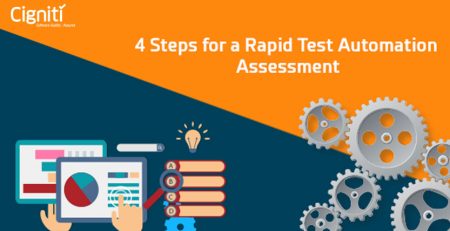Test Automation: The Need to Get More Focused in 2018
New and emerging technologies are changing the dynamics of software development and testing. New tools and fresh approaches are needed to make the software much more robust and market-ready. It impacts the way in which software products are developed and tested on the QA front. Software testing is no more an isolated function, as it needs to effectively collaborate with development teams to build high quality and error-free software.
Test Automation has been a great enabler in the software development process, especially to build sound software at super speed. Speed with the right blend of quality has been one of the greatest strengths of Test Automation. We have been witness to the fantastic performance of licensed as well as Open Source test automation suites/frameworks. The best part is, these tools and automation platforms have evolved and progressed with the kind of requirements and challenges the industry has posed.
The transformation in development and testing methodologies has not only impacted the processes, but has also changed the way automation tools have learnt to squeeze in. The objective has been to develop robust, high quality, and flawless software. When applications grow in complexity and automation experts gain diverse experiences, changes happen in the test automation market.
As per a recent report published by Zion Market Research, ‘The test automation market is expected to witness significant growth due to the increasing trend of digital transformation across the globe. Increasing investment in IT sector increases the demand for test automation. The major driving factor for test automation market is the benefits offered by these tools like time and cost consuming, easy to test for multi lingual sites, no need of human intervention, enhance the speed of test execution.’
The need for Test Automation to grow and evolve is thus evident. Let us look at a few ways in which it must get more focused for the upcoming challenges.
Virtual Test Environments and Digital Transformation
Cost-effectiveness and resource optimization will be some of the key elements considered in the software development process. The test environments will evolve and get more equipped, which will enable added flexibility and feasibility for all testing requirements. Digital Transformation will propel the need for Agile and DevOps methodologies to offer greater flexibility and instantaneous updates.
Test Automation will have to adapt to these changes and offer solutions to operate in these volatile development scenarios. Testing frameworks will have to get more robust and reusable to bring in cost-effectiveness and efficiency not just for single testing requirement but for any similar testing needs in the future. Currently, we see a lot of permanent test environments, which is going to change and virtualization will be the key to boost agility and speed.
Gear up for the Open Source Movement
Software Testing and QA forms a major chunk of the software development costs. It has been estimated to be almost 30% of the total development expenditure. Licensed tools come with a cost along with many other compelling benefits, however, open-source tools seem to have changed the overall dynamics. Along with a pool of testing community contributors, open-source offers the added cost-effectiveness. Nevertheless, there are a whole lot of adjoining challenges to deal with as well. This implies that the automation scenario is changing.
All thanks to the open source movement, the need for more responsive and robust automation platforms will grow and the market will have to respond. Even open-source tools/automation platforms will have to stay upgraded and responsive to any/every user requirement.
New and Emerging Technologies – AI, Blockchain, and more
The overall tech scenario seems interesting and a lot is happening at this moment. Consequently, there is an excessive need for software testing and quality assurance to bring its relevance and application for the business. There is no definite way of testing these technologies for the business requirements. Automation suites will have to emerge and evolve, get in sync with the changing requirements for testing these technologies.
Moreover, adoption of Artificial Intelligence in test automation is already getting popular. It is expected to bring more intelligence, efficiency, validation, and automation to testing. It will further enhance test coverage and improve the performance of application with better testing performance.
Focus on Security with DevSecOps and DevTestOps
Security Testing is growing in significance with the increasing number of threats and cybersecurity incidents in 2017. DevSecOps and DevTestOps is the fresh way to go and enterprises are incorporating them within the testing scope. Security can’t be an after-thought and crawl in after testing the application for performance and other aesthetics.
Test Automation will have to emerge and develop focussed capabilities to enable robust security testing with the needed variations for varying objectives. Security at speed will be the underlying statement.
Need for Integration and Consolidation
The need for Continuous Testing and Continuous Delivery will only grow and would need many modes to make it happen. There are good chances that it might not work with a single testing tool or platform. Any of these testing requirements might need integration of tools and frameworks to make it happen effectively.
Practically, enterprise will need new agile tools for test automation and an Omni-channel test management approach to ensure the desired outcome.
Total Automation with Test Automation
While combination of Manual Testing and automated testing might be a good option for some, enterprises are increasingly looking at end-to-end automation of some test processes. At the same time, teams have to be careful while strategizing automation of the tests to avoid overdoing it. Deciding on the parts of the application to be automated is critical.
Automation across the entire software development lifecycle might be a necessity, but it has to be effectively planned, and the tools need to gear up for the same with the right metrics and frameworks to support.
In Conclusion
Test Automation is tricky, however, if done with a well-thought-through strategy, it can enable teams and give that extra time span to look at the project objectively. The market size for test automation is definitely increasing and is surely promising, but there is a serious need for adopting the right strategy and tools to make it work for your business. When it comes to test automation getting evolved and further focussed, frankly, it is inevitable.
Cigniti utilizes proprietary test techniques to identify automatable manual tests. Cigniti’s test automation methodology (and team) is well accustomed to Agile and DevOps environments ensuring consistent ROI during the entire agile lifecycle.
Connect with Cigniti’s test automation experts to implement automated test suites with a focus on long term utilization of the suites.





Leave a Reply